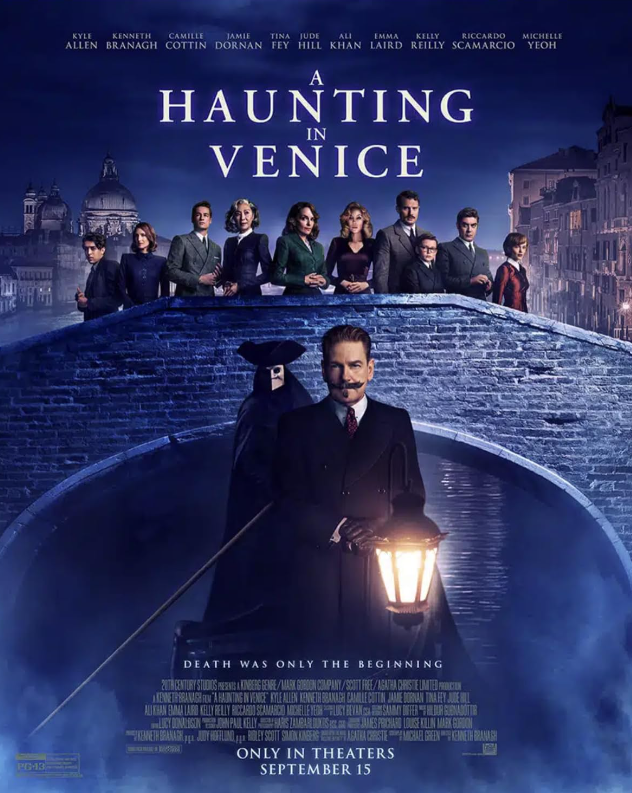Seated in a dimly lit theater before “A Haunting in Venice,” my heart fluttered as I eagerly anticipated an impending scare. However, as the minutes passed, my expectation of spine-tingling chills transformed into nothing but yawns and, well, disappointment.
“A Haunting in Venice,” directed by and starring Kenneth Branagh as Detective Hercule Poirot, was heavily marketed as a fusion of murder mystery and horror, yet it managed to fumble in both categories. The film, released on Sept. 15, had all the ingredients for success — an iconic cast of legendary actors and visually stunning aesthetics. However, it proved to be a total disappointment, wrecked by a narrative that fell flat.
To those unfamiliar with the plot, the film serves as a sequel to “Death on the Nile” and “Murder on the Orient Express,” which are both based on Agatha Christie novels and tell the tales of Detective Poirot uncovering murders. The story takes place in Venice, where a writer named Ariadne Oliver, portrayed by Tina Fey, approaches a retired Detective Poirot and asks him to investigate a fraud. Oliver persuades Poirot to attend a séance, an event aimed at communicating with the deceased. Their goal is to reveal Joyce Reynolds, portrayed by Michelle Yeoh, as a fraudulent medium who claims to connect with the spirit world.
The events of the film take place at the Palazzo of famous opera singer Rowena Drake, portrayed by Kelly Reilly, who hires Reynolds to connect with her dead daughter Alicia. A collection of guests attend the séance, including Alicia’s ex-fiancé Maxime Gerard, played by Kyle Allen, the Drake family doctor Leslie Ferrier, played by Jamie Dornan, Ferrier’s son, and Drake’s housekeeper Olga Seminoff, played by Camille Cottin. Without spoiling the film, let’s just say that a very eventful séance with spirits and ghosts leaves the characters shocked and traumatized.
Before discussing the disappointing plot, I have to acknowledge the very talented cast. First, the return of Branagh as Detective Poirot is an ideal fit — every detail from his dramatic mustache to the perfected Belgian accent just works. No matter how accomplished Branagh’s performance is, it’s Yeoh’s portrayal of the psychic medium that truly steals the spotlight as the best cast role in the entire film. The recognition of Yeoh’s talent is specifically warranted during the actual conjuring of and communication with the dead. Her trembling hands, calm voice, frightened expressions and agonizing screams are the only true horror in the entire film and perhaps its saving grace.
In stark contrast, I find it impossible not to vehemently criticize the casting of Fey in the role of the novelist, Oliver. Tina Fey is undoubtedly a master of comedy, with her witty humor and impeccable comedic timing endearing her to audiences worldwide. However, in “A Haunting in Venice,” her attempt at a serious role fell far short of expectations. There was a noticeable lack of connection between Fey and the role of the novelist, resulting in a somewhat jarring performance that left viewers yearning for her signature humor. Perhaps it’s a sign that in the world of acting, not all comedians are destined to shine in dramatic roles, and Fey’s true forte remains in the realm of comedy. But at least we had Yeoh’s exceptional casting to save the day.
The main success of “A Haunting in Venice” lies in the exceptional cinematography that showcases the mesmerizing beauty of Venice and the grandeur of the Palazzo where the story unfolds. The film’s ability to capture the enchanting canals and historic architecture of Venice is nothing short of breathtaking, offering viewers an immersive experience into the heart of the city. The visual compositions and camerawork in the film, at times, reach perfection. The carefully framed shots and the camera’s focus on the actors’ performances provide a captivating backdrop to the unfolding narrative. However, amid the brilliance of the cinematography, some scenes are marred by an almost pitch-black screen, leaving the audience straining to discern any details.
All the discussion about characters and visuals leads me to my ultimate point — the horror in the film, or lack thereof. With Yeoh’s impeccable casting, stunning visuals and a palpable connection to the spirit realm, one would naturally expect an ample dose of jump scares and spine-tingling moments. However, the most horrifying aspect of the entire movie experience was the fact that, for nearly two hours of my life, I had eagerly anticipated a fright, only to leave utterly disappointed and a little sleepy.



